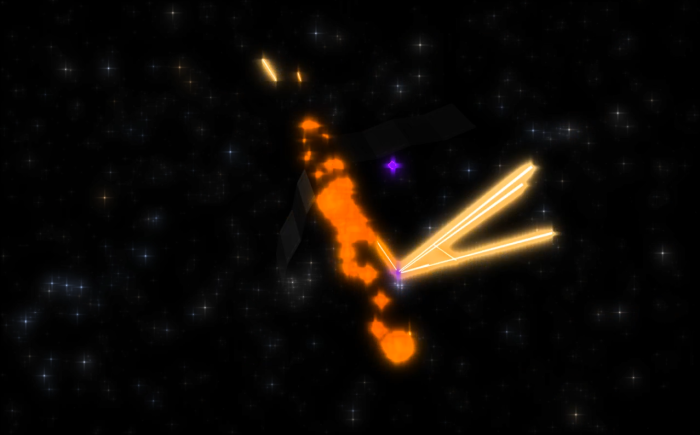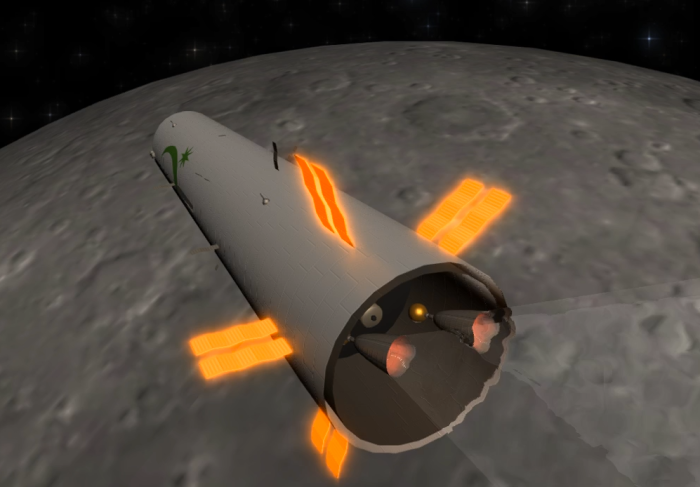Children of a Dead Earth never compromises scientific accuracy for anything, especially not visuals. This leads to a lot of counter-intuitive visual effects, so this is a page explaining some of them.
The first thing you may wonder is why lasers appear to be visible and slow moving in the game, since they obviously are not in real life.
Those are not lasers, not the orange beams, not the red beams, not the purple ones! Those are all pyrotechnic tracers on projectile weapons. Tracer rounds are used to correct accuracy of bullets, and the differing colors are different pyrotechnic colorants (which all use real world emission spectra data to approximate their real life color). Different colors are used between different weapons to help targeting software distinguish between them.
This is an actual laser in game: The violet flash up high is a ship tens of kilometers away firing a violet laser, and the violet flash on the ship with ejected glowing matter is the laser impact. The actual beam is invisible, and all you can see is the firing location, and the impact location. The firing location is visible due to diffraction. When the laser is not in the visible range of light, all that you will see is the ejected matter, and the subsequent red or orange glow of melted armor.
The violet flash up high is a ship tens of kilometers away firing a violet laser, and the violet flash on the ship with ejected glowing matter is the laser impact. The actual beam is invisible, and all you can see is the firing location, and the impact location. The firing location is visible due to diffraction. When the laser is not in the visible range of light, all that you will see is the ejected matter, and the subsequent red or orange glow of melted armor.
Next up, why does engine exhaust look like that? I’ve seen SpaceX’s rockets launch, and their exhaust looks nothing like that.
First, the shape. One usually finds rocket exhaust to appear as curving away from the nozzle, possibly with bright shock diamonds. As a rocket gets higher in altitude, the curvature lessens, because the air pressure lessens. In space, with no atmosphere, the curvature vanishes entirely, and the exhaust plume expands outward linearly.
The angle of expansion is dependent upon two things: the exhaust velocity of the rocket itself, and the temperature of the plume at nozzle exit. The temperature is important because it directly governs the outward velocity of the plume: hotter temperatures means the gas expands faster. A plume which expands at the same speed as the rocket’s exhaust velocity will have a 45 degree angle of expansion. As you can see in the above image, the angle is less than that, so the exhaust velocity must be greater than the expansion velocity.
Second, why is it transparent rather than a bright orange or white plume? In atmosphere, the air pressure compresses the exhaust as it tries to expand, which causes it to curve back in on itself and form shock diamonds. As a result, the temperature of the gas remains hot, hot enough to keep emitting tremendous amounts of light. In space, the exhaust gas expands unrestricted, and the temperature drops immediately as soon as the exhaust leaves the nozzle. This is simple gas laws: in an unrestricted vacuum, a gas will expand in volume and reduce in temperature as the kinetic collisions between the molecules lower rapidly.
Finally, what about the shimmering effect? Is that supposed to happen in a vacuum? It does, whenever the gas’s index of refraction differs from that of the medium it is in (in this case, vacuum, which has an index of refraction of 1). In the above image, the exhaust is dissociated methane, and the carbon expelled does have a refractive index different enough from vacuum in the visible range. However, you will find that other engines, such as rockets which have only pure hydrogen in their exhaust plumes, will not have this shimmering effect, since hydrogen has an index of refraction very close to 1 at visible ranges.
That’s all for now, more to follow!
I’m interested to know why there’s 3-ish ejection paths in the laser image above. To what degree is the laser impact simulated? Also, what’s the cross-bar thing going on in the ejected metal? Mb this can be handled in another blog.
LikeLike
In reality, there would be an enormous amount of ejection paths, but there are only three in the image for performance reasons (and you would only notice it in a still image). The angle of ejection is correct, however. The cross-bar thing is actually ejecta from a previous frame, since in the actual shot, the laser has been chopping away at the target for some time now, as evidenced by the glowing shell.
LikeLike
Could someone please explain me how those pyrotechnic tracers work in space? I always thought that air would be needed to ignite them, or am I wrong with that assumption?
After all, constantly pumping down air the Railgun barrel would be literally impossible.
So how do they work? I would really appreciate an answer.
LikeLike
Modern ammunition and pyrotechnic tracers contain their own oxygen or oxidizer chemically bonded to a (solid) salt within each round.
LikeLike